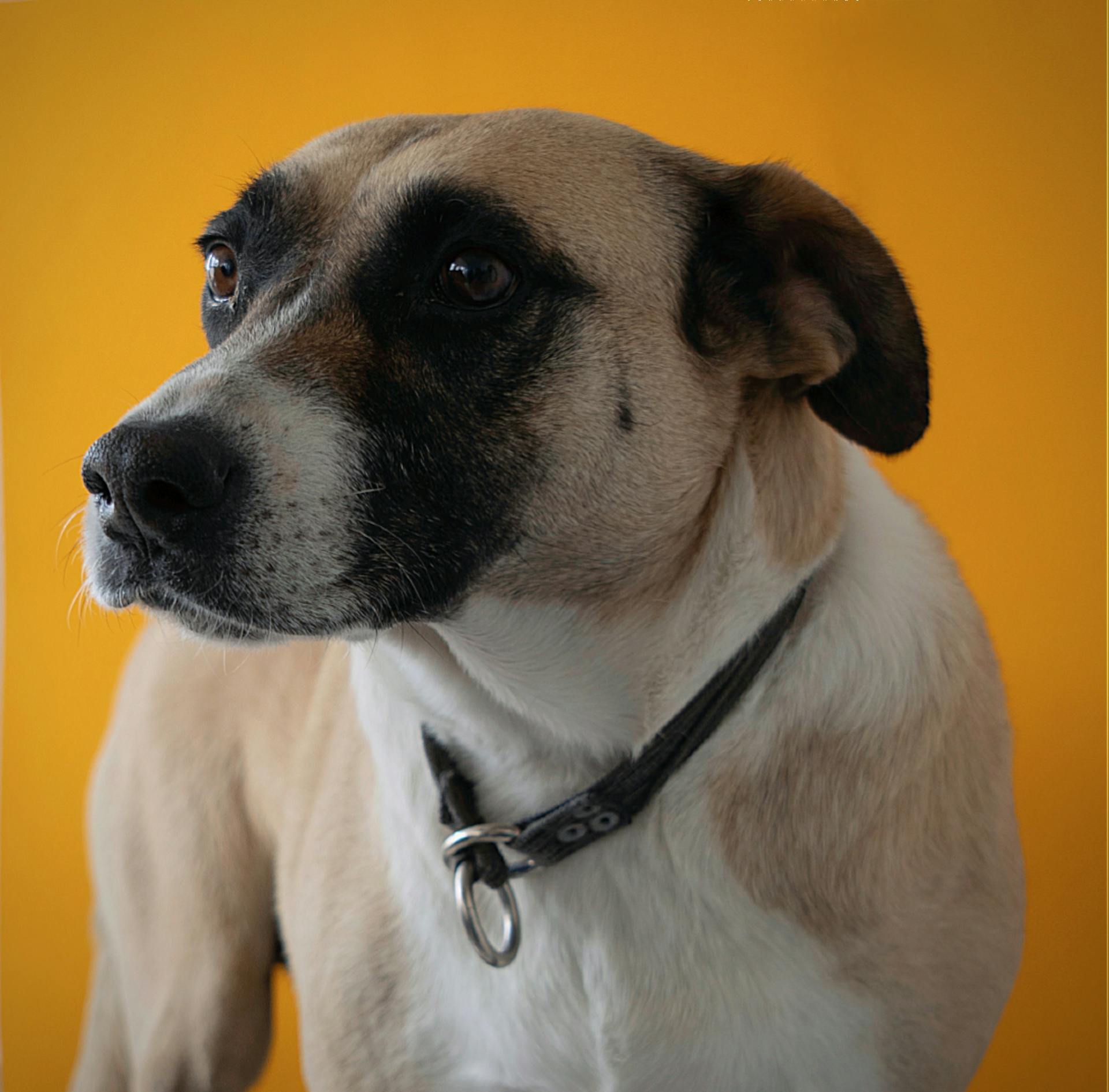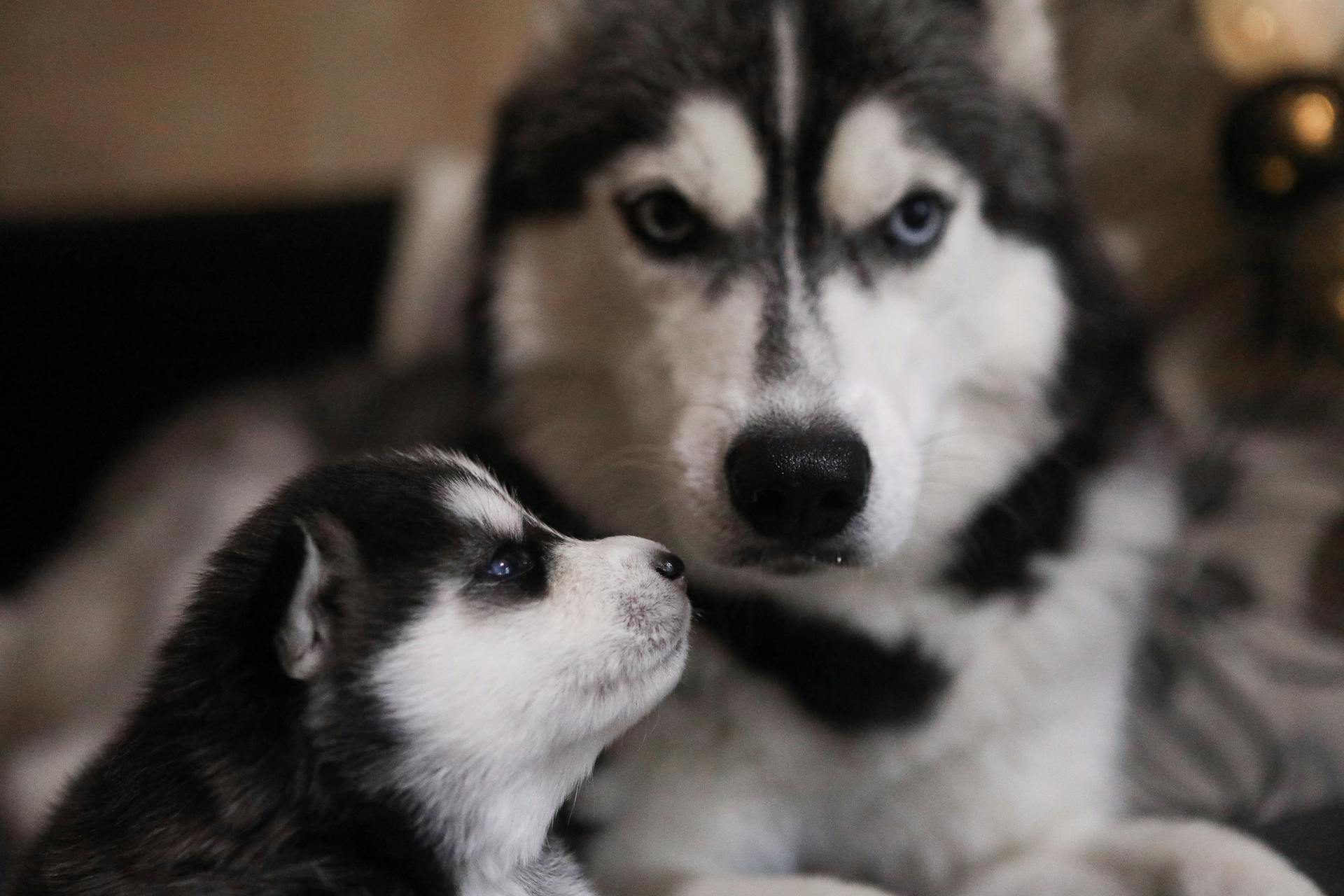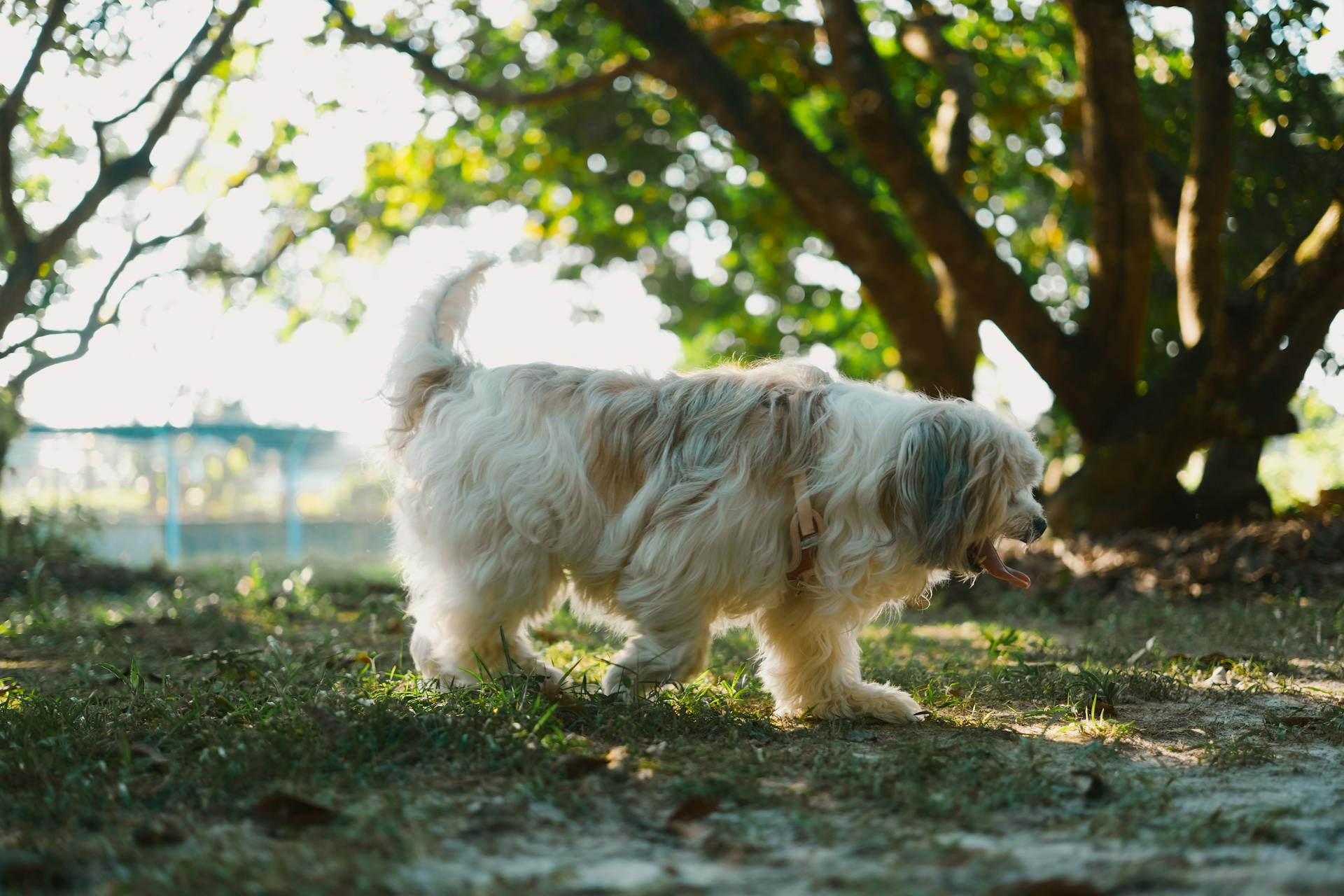
The Perro Xoloitzcuintle is an ancient breed with a rich history that dates back to the time of the Aztecs. They were considered sacred animals and were often buried with their owners.
This breed is also known as the Mexican Hairless Dog, due to its unique characteristic of being either hairless or having a short, smooth coat.
The Perro Xoloitzcuintle comes in three sizes: Toy, Miniature, and Standard, each with its own unique features and characteristics.
For another approach, see: Xoloitzcuintli Breed Standard
Genetics and Breeding
The Xoloitzcuintle's unique appearance is largely due to a genetic condition called canine ectodermal dysplasia, caused by a mutation on the FOXI3 autosomal gene.
This condition results in the absence of hair and some teeth, making it a distinctive feature of the breed.
The Xoloitzcuintle's genetics are also interesting, as they have a unique genetic signature that is almost gone due to their assimilation into the Eurasian dog gene pool.
The breed's DNA sequences are identical to those of dogs from the Old World, and studies have shown that domesticated dogs entered North America from Siberia 4,500 years ago.
In 2020, the sequencing of ancient dog genome indicated that the Chihuahua and Xoloitzcuintli derive 4% and 3% of their ancestry from pre-colonial dogs, almost entirely being descended from Eurasian dogs.
The Xoloitzcuintle's genetic makeup is also influenced by a mutation on the FOXI3 autosomal gene, which causes the absence of hair and some teeth.
This mutation is inherited as a monogenic autosomal semidominant trait, meaning that the absence of hair is determined by a single gene on a non-sexual chromosome.
The Xoloitzcuintle's genetic characteristics can be summarized as follows:
- Genetic condition: Canine ectodermal dysplasia
- Cause: Mutation on the FOXI3 autosomal gene
- Effect: Absence of hair and some teeth
- Genetic inheritance: Monogenic autosomal semidominant trait
Recognition and Standards
The Fédération Cynologique Internationale (FCI) finally recognized the Xolo as an official purebred in its native Mexico in 1956, after a decade of efforts to save the breed from extinction.
The breed was first recorded by the American Kennel Club (AKC) in 1887, with a Mexican dog named "Mee Too" becoming the first AKC-registered Xolo.
The Xolo Expedition of 1954 was a widely publicized effort to discover purebred Xolos in remote areas of Mexico, which led to the discovery of 10 structurally strong dogs that formed the foundation of Mexico's program to revive the breed.
Related reading: American Hairless Terrier vs Xolo
The first official standard for the breed was authored by a committee headed by Norman Pelham Wright, and it was recognized in Mexico on May 1, 1956.
A Mexican dog named "Chinito Junior" became the breed's only AKC champion to date, earning his title on October 19, 1940.
The Xoloitzcuintli Club of America (XCA) was founded on October 26, 1986, to regain AKC recognition for the breed, and it has since worked tirelessly to promote the breed and compile a stud book modeled on requirements for eventual AKC acceptance.
The breed was dropped from the AKC stud book in 1959 due to its scarcity and perceived extinction, but it was readmitted to the Miscellaneous Class in 2009 and has since been eligible to be shown in the AKC Non-Sporting group.
Here are the key milestones in the breed's recognition and standards:
- 1954: The Xolo Expedition discovers 10 structurally strong Xolos in remote areas of Mexico.
- 1956: The breed is recognized as an official purebred by the FCI in its native Mexico.
- 1959: The breed is dropped from the AKC stud book due to scarcity and perceived extinction.
- 1986: The Xoloitzcuintli Club of America (XCA) is founded to regain AKC recognition for the breed.
- 2009: The breed is readmitted to the AKC Miscellaneous Class.
- 2011: The breed becomes eligible to be shown in the AKC Non-Sporting group.
Características
The Xoloitzcuintle has a calm and attentive temperament.
They are good companions and guardians of the home, depending on their size. Some people appreciate their intelligence, making them easy to educate, and their friendly character.
Their unique appearance, which includes a sleek body, almond-shaped eyes, and large bat-like ears, is quite striking. The breed comes in a range of sizes, which breeders have standardized into three designations: Standard, Miniature, and Toy.
The Xoloitzcuintle's dominant hairless trait originated as a spontaneous mutation thousands of years ago. This trait is responsible for their lack of fur, which can cause a higher loss of body heat, requiring them to maintain a temperature of around 40°C.
Their skin can be marked, splashed, or spotted, and they come in a variety of colors, including black, grey, bronze, yellowish-blonde, blue, and red. The breed's unique characteristics make them a popular choice for some people.
The Xoloitzcuintle's lack of fur also makes them less prone to problems caused by fleas and ticks. However, it's worth noting that some individuals may exhibit different degrees of hair growth.
Salud y Cuidados
The Xoloitzcuintle is generally not prone to health and structure problems due to thousands of years of natural selection. They can adapt to various climates, but tropical origins mean they're not suited for outdoor life in colder temperate and northern climates.
They should be considered an indoor dog breed and need regular bathing, light grooming, and skin care to prevent acne and skin problems. Poor breeding, neglect, or over-bathing and over-lotioning can lead to skin issues.
Their skin can be prone to dryness, especially in Xolos without fur, which can be uncomfortable and lead to lesions. Applying baby oil can be a good protection, especially during hot weather.
Xolos without fur are also susceptible to sunburns on their exposed skin, so it's essential to use sunscreen or a fine fabric cover-up on sunny days.
While Xolos without fur are less susceptible to parasites, their thick skin can make it harder for them to heal from wounds. Regular dental care is also crucial, and using dog-specific toothbrushes and toothpaste is essential.
Overall, the Xoloitzcuintle requires regular care and attention to stay healthy and happy.
In Culture and History
The Xoloitzcuintle has a rich cultural significance in Mexico, dating back to the Aztecs. This ancient breed was considered a symbol of good luck and was often depicted in art and literature.
The Xoloitzcuintle's name is derived from the Aztec god Xólotl, associated with death and fire. In Aztec mythology, the Xoloitzcuintle was believed to be a loyal companion that would guide the deceased to the afterlife.
In contemporary culture, the Xoloitzcuintle has become a popular pet and a symbol of Mexican heritage. Museo El Carmen in Mexico City featured a show titled "Xolos, compañeros de viaje" in 2019-20, showcasing over 100 artifacts that highlight the importance of the Xoloitzcuintle in Mexican culture.
The Xoloitzcuintle has also been featured in various forms of media, including the Disney/Pixar film Coco, where a Xolo named Dante stars as a main character. Additionally, the breed has been depicted in some of Frida Kahlo's paintings, including "The Love Embrace of the Universe, the Earth (Mexico), Myself, Diego, and Señor Xolotl", which is featured on the 2007 500-peso note.
The Xoloitzcuintle's unique characteristics, such as its lack of fur and early tooth loss, have made it a subject of interest in various fields, including art and science.
Here are some notable mentions of the Xoloitzcuintle in popular culture:
- Club Tijuana, a professional soccer club, uses the Xoloitzcuintle as its symbol and mascot.
- A Xolo named Dante appeared in the Disney/Pixar film Coco.
- The breed has been featured in various artworks, including those by Frida Kahlo.
- A Xolo was exhibited in the Royal de Luxe street theater performances in Guadalajara, Mexico, and other cities.
- A Xolo won first place in the "Animal Framer" Life Framer competition in 2015.
The Xoloitzcuintle's cultural significance extends beyond Mexico, with the breed being recognized as a symbol of the country's rich heritage.
Care and Nutrition
To care for your Xoloitzcuintle, it's essential to understand its specific nutritional needs. Cachorros pequeños, or small puppies, require 4 to 5 small meals a day until they reach 10 weeks of age.
As your Xoloitzcuintle grows, its feeding schedule changes. Between 10 weeks and 5 months, it needs 3 meals a day. After the fifth or sixth month, you can switch to 2 meals a day.
Protein and vitamins are crucial for a Xoloitzcuintle's skin health, so be sure to provide the right amount in their diet.
To determine the right amount of protein and vitamins for your Xoloitzcuintle, consult with your veterinarian.
Here's a quick guide to your Xoloitzcuintle's daily needs:
- Collar and leash: A well-fitting collar is a must, as Xoloitzcuintles have no protective coat. An adjustable collar or a soft, padded collar can be helpful.
- Cuencos: Provide at least two bowls for food and water.
- Place to sleep: A comfortable, sturdy bed or a soft cushion is perfect for your Xoloitzcuintle.
- Clothing: Your Xoloitzcuintle may need protective clothing, but make sure it fits well to avoid constriction.
Alimentación
Feeding your furry friend is a crucial part of their care and nutrition. You should feed your puppy small meals frequently, up to 10 weeks of age, with 4 to 5 meals a day.
As your puppy grows, you can gradually reduce the number of meals. Between 10 weeks and 5 months, 3 meals a day are sufficient. After that, you can switch to 2 meals a day.
Here's a summary of the meal frequency for your puppy's different stages:
- 4-5 meals a day until 10 weeks of age
- 3 meals a day between 10 weeks and 5 months
- 2 meals a day after 5 months
Accesorios Adecuados
When choosing a collar for your Xoloitzcuintle, make sure it fits well since they don't have protective fur.
A well-fitting collar is essential, and a padded collar can be particularly helpful, especially for puppies who may pull on the leash. An arnés can be a good option to prevent injuries.
Your Xoloitzcuintle needs at least two bowls and a fixed place to sleep. A cushioned basket or a dog bed is a great option, and you can also consider placing a blanket on the sofa.
Xoloitzcuintles often require protective clothing, so ensure it fits properly to avoid constriction or skin irritation. A well-fitting outfit is a good sign if your dog enjoys running and playing while wearing it.
A good first-aid kit for your Xoloitzcuintle should include a nail clipper, a dog toothbrush, and dog-specific toothpaste. Consult your veterinarian for a recommended list of kit contents.
Your Xoloitzcuintle will appreciate toys that challenge them physically and mentally.
Frequently Asked Questions
¿Cuál es el perro que representa a México?
El xoloitzcuintle es el perro que representa a México, siendo una raza nativa y emblemática del país. Conoce más sobre esta leyenda viva y su importancia cultural
¿Cuántos perros xoloitzcuintles hay en México?
En México, se registran anualmente alrededor de 750 perros xoloitzcuintles. Esto los convierte en la población más grande de este raro y antiguo perro mexicano.
What are sacred dogs in Mexico?
In Mexican culture, the Xoloitzcuintle is considered a sacred dog that guided its deceased master through the underworld, as believed by the ancient Nahuas. This ancient breed is still revered for its unique characteristics and spiritual significance.
What is the Mexican Hairless Dog myth?
According to Mexican creation stories, the Xoloitzcuintli (Mexican Hairless Dog) was formed from the same Bone of Life as humans, serving as a guardian and spiritual guide. This ancient mythological significance is still celebrated today, earning the breed a special place in Mexican culture.
What is the dog of the dead in Mexico?
The Xoloitzcuintli, also known as the Xolo, is a breed of dog revered in Mexico as a symbol of protection and loyalty in both life and the afterlife. This ancient canine companion is deeply rooted in Mexican culture and traditions surrounding death and the afterlife.
Sources
- https://en.wikipedia.org/wiki/Xoloitzcuintle
- https://es.wikipedia.org/wiki/Xoloitzcuintle
- https://www.ngenespanol.com/animales/xoloitzcuintle-leyenda-del-perro-azteca-prehispanico-y-su-significado/
- https://www.hundeo.com/es/dog-breeds/xoloitzcuintle/
- https://www.canuto.com.mx/blogs/tips-para-tu-perro/la-leyenda-del-xoloitzcuintle-el-perro-azteca
Featured Images: pexels.com


